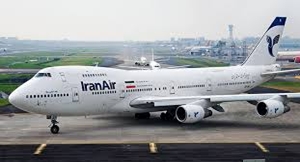Post-sanctions Iran moving fast to upgrade civil aviation
04 Feb 2016
Just two weeks after the United States and Europe lifted sanctions on Iran prohibiting the sale of aircraft and parts, the country is making moves to revamp its aging fleet and antiquated air traffic infrastructure.
Within Iran, passenger airlines currently operate a relatively small fleet of about 250 aircraft, of which only about 150 are operational after more than three decades of sanctions left the country's fleet in desperate need of modernization, Deloitte's Aerospace and Defense Lead Tom Captain told Avionics Magazine.
Iran Air is likely to need 500 to 600 new aircraft in the next two decades. ''After a little over 35 years, the agreement for lifting of sanctions is now only days old and among the assets that are being unfrozen are hundreds of billions of dollars, which allows them to modernise infrastructure after years of neglect in a couple of very critical sectors, including the air transportation system,'' said Captain.
Since the sanctions were imposed on the country in 1979, US entities have been restricted from engaging in sale, lease or transfer of commercial passenger aircraft and related parts and services to Iran, according to US law firm Pillsbury, Winthrop, Shaw, Pittman.
Furthermore, Pillsbury notes that non-US entities have been forbidden from these transactions if the aircraft or related components or technology incorporated 10 per cent or more US-origin controlled content by value. Even for aircraft containing less than 10 per cent US-origin content, these prohibitions applied to re-exports of US-origin spare parts and technical data.
Similar restrictions applied to European countries until the Joint Comprehensive Plan of Action (JCPOA) lifted these sanctions earlier this month, prompting the country's flag holder, Iran Air, to place an order for 118 aircraft with Airbus, just days after the JCPOA was implemented.
''The sanctions were quite onerous on the air transportation system. It restricted aircraft purchases, resulting in old equipment being flown which was dangerous and very inconvenient,'' Captain said, noting that spare parts and refuelling stops and services have also been largely restricted under the sanctions.
''As a result of the sanctions, lack of spare parts and so forth, the accident rate in Iran rose significantly in the last 35 years. It is estimated that something on the order of 1,500 people have died in aircraft accidents since the revolution started. The incentive to recapitalize the fleet is huge, not only for economic reasons but also to improve the safety record.''
Iran has an average fleet age of 25 years, according to Planespotters.net, which places the average aircraft of the state-owned Iran Air's fleet at 27 years - nearly twice the average in-service international fleet age. While the country has already ordered 118 Airbus aircraft to replace its ancient and dangerous fleet, Captain estimates Iran will need to absorb between 500 and 600 aircraft into the country in the next 20 years.
At prices in the way of $100 million per aircraft, the country is likely to spend between $30 billion and $50 billion on airplanes in the next 20 years to both replace the mainly second-generation aircraft in its fleet and augment the growing need for transportation.
Captain believes the lion's share of this is likely to benefit the ''current duopoly'' of Airbus and Boeing, although there are some other companies that make large turboprops and regional jets that have a chance at the market as well. For commercial aircraft, however, avionics retrofits are not in the country's future.
''The airlines will not likely be upgrading older aircraft they intend to replace anyway,'' said Captain. ''They will be buying new aircraft with modern generation avionics.'' The new aircraft will be equipped with digital data communications, Automatic Dependent Surveillance-Broadcast (ADS-B) In and Out, Traffic Collision Avoidance Systems (TCAS) and GPS as well as the latest receivers and transponders to connect to the Ground-Based Augmentation Systems (GBAS).
To incorporate the new aircraft with new capabilities, however, the country will also have to update its badly outdated Air Traffic Control (ATC) system. ''Of course [airlines] will need to upgrade and modernize the antiquated air traffic control infrastructure including the ground radar, communications, GPS, etc. The airlines in the country will be buying aircraft that are already equipped with ADS-B In and Out and TCAS as well as other modern navigation and safety electronics, but the ground stations, the radars, communications and procedures, including not only the infrastructure but the trained personnel to operate it will be going through an expedited course of improvement,'' said Captain.
This could create a major opportunity for companies that provide aviation infrastructure, such as radar. ''We expect that economic activity will drive the pace and amount of modernization that goes on [in the aviation industry]. The oil industry will need support, travel restrictions being lifted will allow for more traffic in the airports, so we would expect to see investments in those areas for both infrastructure on the ground as well as passenger capacity to drive some of the investments that are being made,'' said Captain.






























